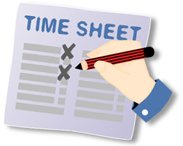 A lot of professional service organisations have timesheet systems. At the end of the day the primary stock in trade for professional service organisations is time. If you don’t record and understand how an organisation is using it’s available time then how can you manage it?
A lot of professional service organisations have timesheet systems. At the end of the day the primary stock in trade for professional service organisations is time. If you don’t record and understand how an organisation is using it’s available time then how can you manage it?
I am surprised however at how many organisations forego a powerful business management capability by only requiring employees to enter time for billable work. What are the implications of this?
Time spent on customer activities
Billable Projects
Recording billable time spent on servicing a customer is common practise. This is particularly so for Time and Material projects where the customer is billed for the time worked on their projects.
It is not uncommon however to find that certain arrangements have been made on a ‘project by project’ basis that make the management of these particularly difficult. For example what time should be recorded in timesheets for Fixed Price projects or projects that exceed an agreed total number of hours?
Simplification is the key. For Fixed Price projects all time should be recorded in timesheets. It is the categorisation of each timesheet record as billable or non-billable that is important. All time spent up to the agreed number of hours should be recorded as billable and all time beyond the agreed number of hours recorded as non-billable. The same applies to Time and Material projects. The classification of Billable and Non Billable is even more important for T&M projects because this classification should determine if the timesheet record is used to create, or appear on, an invoice or not.
Recording all time spent on the project has a couple of other very important flow on benefits being:- 1) allowing all costs incurred on the project to be calculated and reported and 2) allowing employee utilisation to be reported.
Non Billable Customer Support
Should time spent servicing a customer that is non-billable also be recorded in timesheets? Activities that fall in this category could include attending customer account review meetings, discussions with customers on changing business processes, preparing customer contracts and the like.
If all time spent servicing customers is recorded in timesheets then it will be possible to determine the profitability of the customer as a whole by matching all revenue earned from the customer against the cost of all time spent servicing the customer. If only billable time was recorded in timesheets then it would not possible to determine the profitability of the customer as a whole.
Time spent on business support activities
All employees in an organisation, even consultants that will spend the majority of their time working on customer service projects, will spend some time doing other tasks that are not billable to a customer. These could include such activities as attending training, attending team meetings, providing advice or assistance on a business or product development project.
The question then is should time spent by employees on these types of tasks be recorded in timesheets? There are many benefits of doing so as per the following examples:
- Keeping track of new product and technologies development will provide detailed costing’s to support Research and Development claims as well as provide information to compare against the budgeted cost for each of these projects.
- Reporting and managing costs of administrative functions such as Billing, Payroll processing, Management and Financial Reporting, and others. Ensuring these costs are comparable to other organisations.
- Planning and then tracking the investment in employee training. Confirming that training is being undertaken according to the organisations policies.
- Tracking time spent on sales activities allows the organisation to understand the spend on sales activities over time. Creating specific ‘fixed duration’ and ‘ongoing’ internal sales projects allows time and costs to be more accurately tracked and reported.
- Same for Marketing efforts.
- And others
Recording all time worked by all employees in the organisation allows the organisation to record total employee cost and total revenue by category of activity.
It is then possible to report these categories of activities as a percentage of revenue. For example: what is the % cost of R&D against Revenue, what is the % cost of Sales efforts against Revenue.
Recording timesheets in a business management system allows reporting such as this to be achieved much more quickly than would otherwise be possible by cobbling a report together from the accounting system General Ledger and Payroll. In addition the business management system will allow the information to be reported at lower levels of detail i.e. by Line of Business, Profit Centre, Customer, Employee or Project. Detailed analysis of this is also possible such as Budget V’s Actual, Employee costs within Projects, Projects within Customer and much more.
Some valuable management reports become possible such as:-
- Report investment in Training this year compared to last year by Financial Period
- Rank Customers by Financial Period Gross Profit and compare to ranking last year
- Compare Gross Profit by Line of Business this year compared to Last Year
- Report R&D expenditure as a % of Revenue
- Report Sales effort cost as a % of Revenue by Profit Centre by Financial Period
- And more.
In summary there are many good reasons for employees recording all time that they work and not just time that is billable to the customer.
Our experience is that while there may be initial resistance from employees to recording timesheets as long as the process of entering timesheets is simple and efficient then after a short period of time employees come to accept that it is an important administrative task in the process of working.
